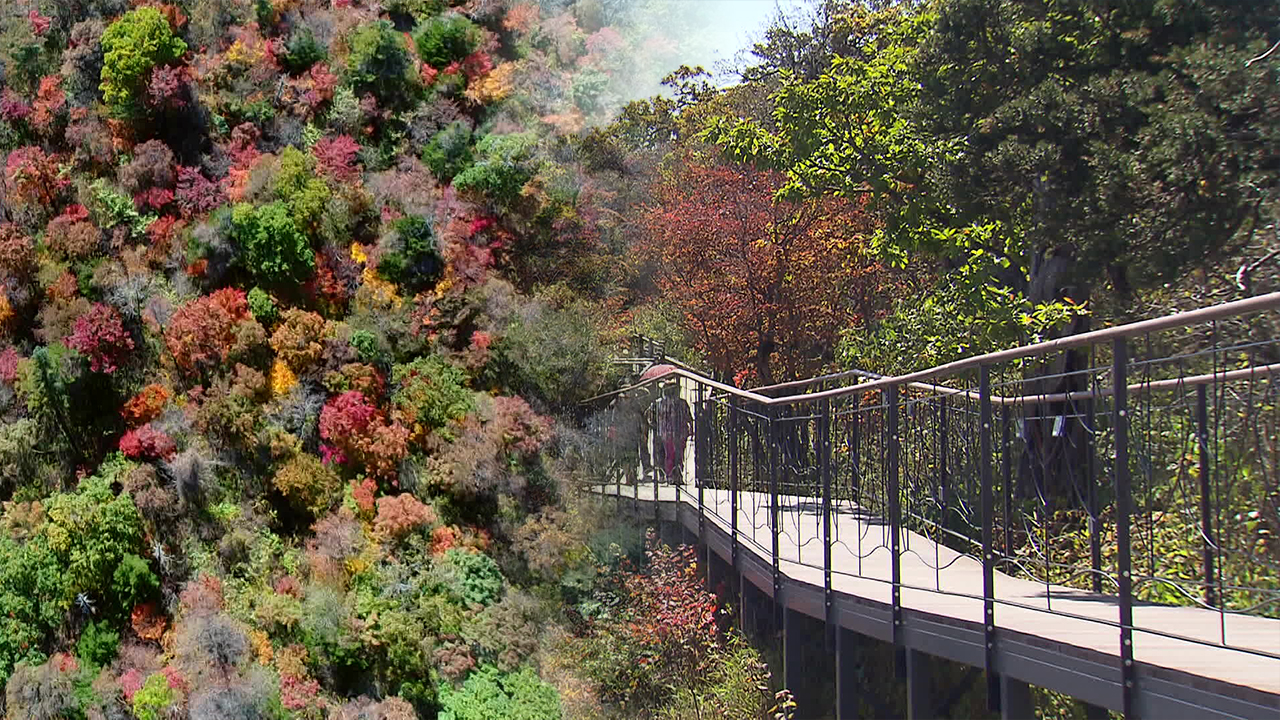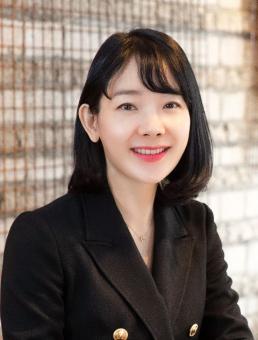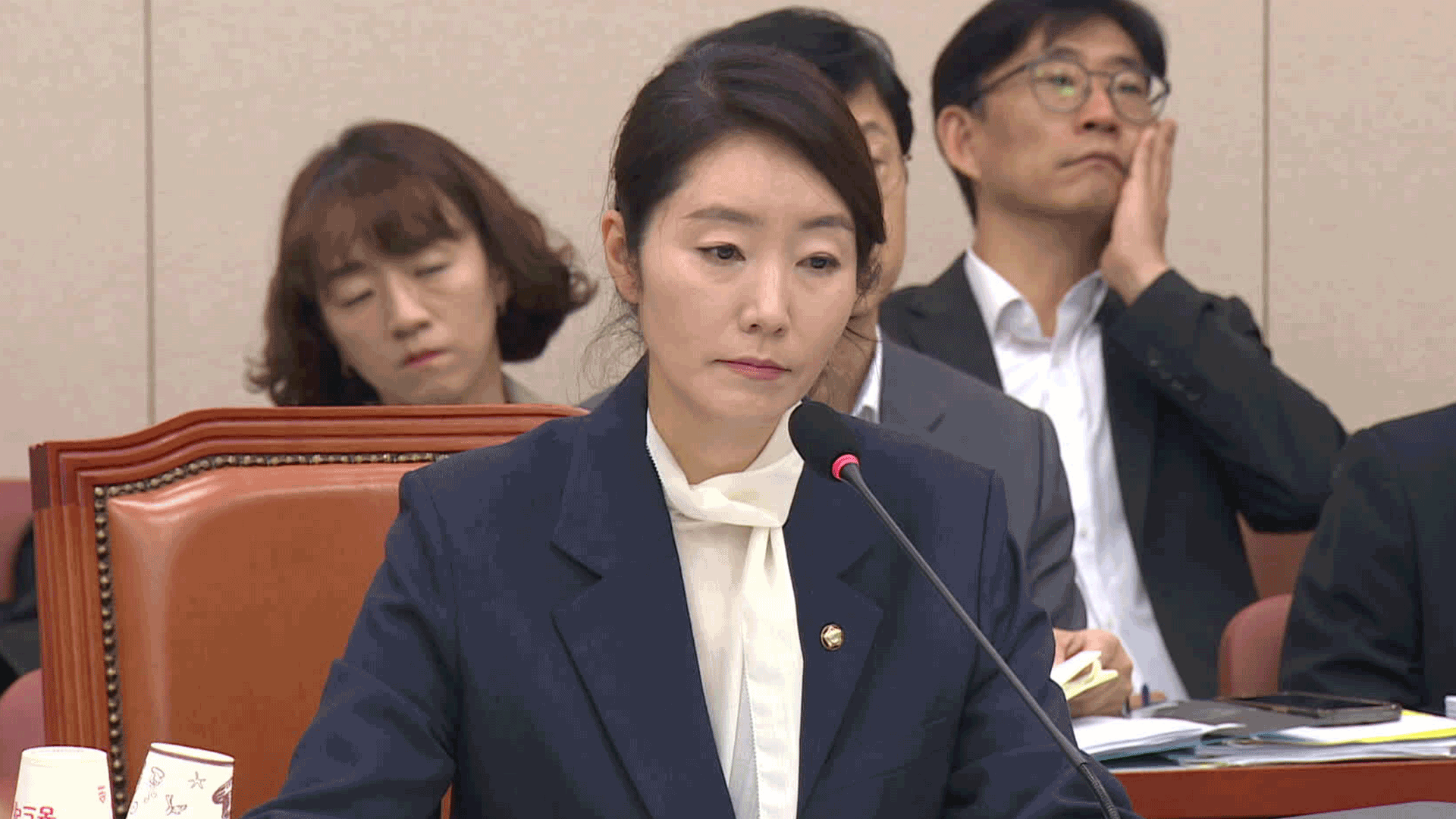Later autumn foliage and earlier spring blooming raise concerns over ecological disruption
입력 2024.11.05 (00:26)
읽어주기 기능은 크롬기반의
브라우저에서만 사용하실 수 있습니다.
[Anchor]
As the cold arrives later than usual, a late autumn foliage has been observed across the country.
The peak of autumn foliage on Bukhan Mountain was observed today (Nov. 4), the latest on record, raising concerns about ecological disruption.
This is a report by meteorologist Shin Bang-sil.
[Report]
Bukhan Mountain serves as the reference point for observing autumn foliage in Seoul.
Forecasters from the Seoul Metropolitan Weather Service are hiking the trails to determine the peak foliage status.
Upon reaching the observation deck, a picturesque autumn landscape unfolds.
[Noh Jeong-soon/Seoul Metropolitan Weather Service: "About 80 percent of the mountain has changed colors, so it appears to be at peak foliage."]
This autumn, the peak foliage on Bukhan Mountain came a week later than usual.
The first signs of foliage also began on October 23, which is 8 days later than the average timing, marking the latest since observations began in 1986.
[Park Choong-sin/Seoul Metropolitan Weather Service: "The most important factors for peak foliage are temperature and precipitation, and this year, the average temperatures in September and October were relatively high...."]
Other famous foliage spots like Seoraksan Mountain and Jirisan Mountain are also experiencing delayed peak foliage, while Naejangsan Mountain and Sokrisan Mountain have yet to report peak conditions.
The trend of autumn foliage is gradually becoming later.
Analysis of major tree species such as maple and oak shows that peak foliage is delayed by an average of 0.13 days each year.
If foliage is delayed, trees have less time to prepare for winter.
[Jeong Soo-jong/Professor, Seoul National University Graduate School of Environmental Studies: "They can't enter dormancy, so the trees have less time to build resistance against the cold. It's similar to a person not being able to sleep."]
In contrast, the blooming period in spring has been coming sooner by an average of 1.28 days each year over the past 15 years.
Concerns are rising that trees are not getting enough rest, which could hinder their growth and negatively impact the ecosystem.
This is KBS News, Shin Bang-sil.
As the cold arrives later than usual, a late autumn foliage has been observed across the country.
The peak of autumn foliage on Bukhan Mountain was observed today (Nov. 4), the latest on record, raising concerns about ecological disruption.
This is a report by meteorologist Shin Bang-sil.
[Report]
Bukhan Mountain serves as the reference point for observing autumn foliage in Seoul.
Forecasters from the Seoul Metropolitan Weather Service are hiking the trails to determine the peak foliage status.
Upon reaching the observation deck, a picturesque autumn landscape unfolds.
[Noh Jeong-soon/Seoul Metropolitan Weather Service: "About 80 percent of the mountain has changed colors, so it appears to be at peak foliage."]
This autumn, the peak foliage on Bukhan Mountain came a week later than usual.
The first signs of foliage also began on October 23, which is 8 days later than the average timing, marking the latest since observations began in 1986.
[Park Choong-sin/Seoul Metropolitan Weather Service: "The most important factors for peak foliage are temperature and precipitation, and this year, the average temperatures in September and October were relatively high...."]
Other famous foliage spots like Seoraksan Mountain and Jirisan Mountain are also experiencing delayed peak foliage, while Naejangsan Mountain and Sokrisan Mountain have yet to report peak conditions.
The trend of autumn foliage is gradually becoming later.
Analysis of major tree species such as maple and oak shows that peak foliage is delayed by an average of 0.13 days each year.
If foliage is delayed, trees have less time to prepare for winter.
[Jeong Soo-jong/Professor, Seoul National University Graduate School of Environmental Studies: "They can't enter dormancy, so the trees have less time to build resistance against the cold. It's similar to a person not being able to sleep."]
In contrast, the blooming period in spring has been coming sooner by an average of 1.28 days each year over the past 15 years.
Concerns are rising that trees are not getting enough rest, which could hinder their growth and negatively impact the ecosystem.
This is KBS News, Shin Bang-sil.
■ 제보하기
▷ 카카오톡 : 'KBS제보' 검색, 채널 추가
▷ 전화 : 02-781-1234, 4444
▷ 이메일 : kbs1234@kbs.co.kr
▷ 유튜브, 네이버, 카카오에서도 KBS뉴스를 구독해주세요!
- Later autumn foliage and earlier spring blooming raise concerns over ecological disruption
-
- 입력 2024-11-05 00:26:49

[Anchor]
As the cold arrives later than usual, a late autumn foliage has been observed across the country.
The peak of autumn foliage on Bukhan Mountain was observed today (Nov. 4), the latest on record, raising concerns about ecological disruption.
This is a report by meteorologist Shin Bang-sil.
[Report]
Bukhan Mountain serves as the reference point for observing autumn foliage in Seoul.
Forecasters from the Seoul Metropolitan Weather Service are hiking the trails to determine the peak foliage status.
Upon reaching the observation deck, a picturesque autumn landscape unfolds.
[Noh Jeong-soon/Seoul Metropolitan Weather Service: "About 80 percent of the mountain has changed colors, so it appears to be at peak foliage."]
This autumn, the peak foliage on Bukhan Mountain came a week later than usual.
The first signs of foliage also began on October 23, which is 8 days later than the average timing, marking the latest since observations began in 1986.
[Park Choong-sin/Seoul Metropolitan Weather Service: "The most important factors for peak foliage are temperature and precipitation, and this year, the average temperatures in September and October were relatively high...."]
Other famous foliage spots like Seoraksan Mountain and Jirisan Mountain are also experiencing delayed peak foliage, while Naejangsan Mountain and Sokrisan Mountain have yet to report peak conditions.
The trend of autumn foliage is gradually becoming later.
Analysis of major tree species such as maple and oak shows that peak foliage is delayed by an average of 0.13 days each year.
If foliage is delayed, trees have less time to prepare for winter.
[Jeong Soo-jong/Professor, Seoul National University Graduate School of Environmental Studies: "They can't enter dormancy, so the trees have less time to build resistance against the cold. It's similar to a person not being able to sleep."]
In contrast, the blooming period in spring has been coming sooner by an average of 1.28 days each year over the past 15 years.
Concerns are rising that trees are not getting enough rest, which could hinder their growth and negatively impact the ecosystem.
This is KBS News, Shin Bang-sil.
As the cold arrives later than usual, a late autumn foliage has been observed across the country.
The peak of autumn foliage on Bukhan Mountain was observed today (Nov. 4), the latest on record, raising concerns about ecological disruption.
This is a report by meteorologist Shin Bang-sil.
[Report]
Bukhan Mountain serves as the reference point for observing autumn foliage in Seoul.
Forecasters from the Seoul Metropolitan Weather Service are hiking the trails to determine the peak foliage status.
Upon reaching the observation deck, a picturesque autumn landscape unfolds.
[Noh Jeong-soon/Seoul Metropolitan Weather Service: "About 80 percent of the mountain has changed colors, so it appears to be at peak foliage."]
This autumn, the peak foliage on Bukhan Mountain came a week later than usual.
The first signs of foliage also began on October 23, which is 8 days later than the average timing, marking the latest since observations began in 1986.
[Park Choong-sin/Seoul Metropolitan Weather Service: "The most important factors for peak foliage are temperature and precipitation, and this year, the average temperatures in September and October were relatively high...."]
Other famous foliage spots like Seoraksan Mountain and Jirisan Mountain are also experiencing delayed peak foliage, while Naejangsan Mountain and Sokrisan Mountain have yet to report peak conditions.
The trend of autumn foliage is gradually becoming later.
Analysis of major tree species such as maple and oak shows that peak foliage is delayed by an average of 0.13 days each year.
If foliage is delayed, trees have less time to prepare for winter.
[Jeong Soo-jong/Professor, Seoul National University Graduate School of Environmental Studies: "They can't enter dormancy, so the trees have less time to build resistance against the cold. It's similar to a person not being able to sleep."]
In contrast, the blooming period in spring has been coming sooner by an average of 1.28 days each year over the past 15 years.
Concerns are rising that trees are not getting enough rest, which could hinder their growth and negatively impact the ecosystem.
This is KBS News, Shin Bang-sil.
-
-

신방실 기자 weezer@kbs.co.kr
신방실 기자의 기사 모음
-
이 기사가 좋으셨다면
-
좋아요
0
-
응원해요
0
-
후속 원해요
0











![[단독] “윤석열·김용현 등 공모해 군사상 이익 해쳐”…외환죄 대신 일반이적죄 적용](/data/layer/904/2025/07/20250714_3VTJV3.jpg)



이 기사에 대한 의견을 남겨주세요.